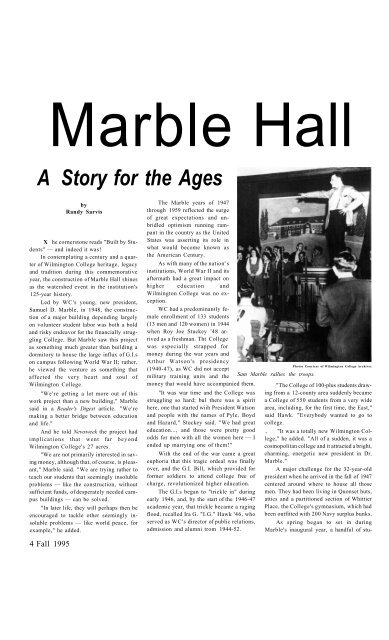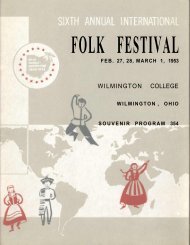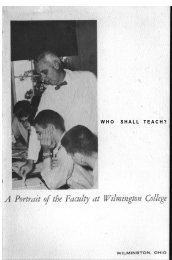Link 1995 10 (Vol. 45, No. 3).pdf - DRC Home - Wilmington College
Link 1995 10 (Vol. 45, No. 3).pdf - DRC Home - Wilmington College
Link 1995 10 (Vol. 45, No. 3).pdf - DRC Home - Wilmington College
You also want an ePaper? Increase the reach of your titles
YUMPU automatically turns print PDFs into web optimized ePapers that Google loves.
Marble Hall<br />
A Story for the Ages<br />
by<br />
Randy Sarvis<br />
X he cornerstone reads "Built by Students"<br />
— and indeed it was!<br />
In contemplating a century and a quarter<br />
of <strong>Wilmington</strong> <strong>College</strong> heritage, legacy<br />
and tradition during this commemorative<br />
year, the construction of Marble Hall shines<br />
as the watershed event in the institution's<br />
125-year history.<br />
Led by WC's young, new president,<br />
Samuel D. Marble, in 1948, the construction<br />
of a major building depending largely<br />
on volunteer student labor was both a bold<br />
and risky endeavor for the financially struggling<br />
<strong>College</strong>. But Marble saw this project<br />
as something much greater than building a<br />
dormitory to house the large influx of G.I.s<br />
on campus following World War II; rather,<br />
he viewed the venture as something that<br />
affected the very heart and soul of<br />
<strong>Wilmington</strong> <strong>College</strong>.<br />
"We're getting a lot more out of this<br />
work project than a new building," Marble<br />
said in a Reader's Digest article. "We're<br />
making a better bridge between education<br />
and life."<br />
And he told Newsweek the project had<br />
implications that went far beyond<br />
<strong>Wilmington</strong> <strong>College</strong>'s 27 acres.<br />
"We are not primarily interested in saving<br />
money, although that, of course, is pleasant,"<br />
Marble said. "We are trying rather to<br />
teach our students that seemingly insoluble<br />
problems — like the construction, without<br />
sufficient funds, of desperately needed campus<br />
buildings — can be solved.<br />
"In later life, they will perhaps then be<br />
encouraged to tackle other seemingly insoluble<br />
problems — like world peace, for<br />
example," he added.<br />
4 Fall <strong>1995</strong><br />
The Marble years of 1947<br />
through 1959 reflected the surge<br />
of great expectations and unbridled<br />
optimism running rampant<br />
in the country as the United<br />
States was asserting its role in<br />
what would become known as<br />
the American Century.<br />
As with many of the nation' s<br />
institutions, World War II and its<br />
aftermath had a great impact on<br />
higher education and<br />
<strong>Wilmington</strong> <strong>College</strong> was no exception.<br />
WC had a predominantly female<br />
enrollment of 133 students<br />
(13 men and 120 women) in 1944<br />
when Roy Joe Stuckey '48 arrived<br />
as a freshman. Tht <strong>College</strong><br />
was especially strapped for<br />
money during the war years and<br />
Arthur Watson's presidency<br />
(1940-47), as WC did not accept<br />
military training units and the<br />
money that would have accompanied them.<br />
"It was war time and the <strong>College</strong> was<br />
struggling so hard; bul there was a spirit<br />
here, one that started wiih President Watson<br />
and people with the names of Pyle, Boyd<br />
and Hazard," Stuckey said. "We had great<br />
education..., and those were pretty good<br />
odds for men with all the women here — I<br />
ended up marrying one of them!"<br />
With the end of the war came a great<br />
euphoria that this tragic ordeal was finally<br />
over, and the G.I. Bill, which provided for<br />
former soldiers to attend college free of<br />
charge, revolutionized higher education.<br />
The G.I.s began to "trickle in" during<br />
early 1946, and, by the start of the 1946-47<br />
academic year, that trickle became a raging<br />
flood, recalled Ira G. "I.G." Hawk '46, who<br />
served as WC's director of public relations,<br />
admission and alumni trom 1944-52.<br />
Sam Marble rallies the troops.<br />
Photos Courtesy of <strong>Wilmington</strong> <strong>College</strong> Archives<br />
"The <strong>College</strong> of <strong>10</strong>0-plus students drawing<br />
from a 12-county area suddenly became<br />
a <strong>College</strong> of 550 students from a very wide<br />
area, including, for the first time, the East,"<br />
said Hawk. "Everybody wanted to go to<br />
college.<br />
, "It was a totally new <strong>Wilmington</strong> <strong>College</strong>,"<br />
he added. "All of a sudden, it was a<br />
cosmopolitan college and it attracted a bright,<br />
charming, energetic new president in Dr.<br />
Marble."<br />
A major challenge for the 32-year-old<br />
president when he arrived in the fall of 1947<br />
centered around where to house all those<br />
men. They had been living in Quonset huts,<br />
attics and a partitioned section of Whittier<br />
Place, the <strong>College</strong>'s gymnasium, which had<br />
been outfitted with 200 Navy surplus bunks.<br />
As spring began to set in during<br />
Marble's inaugural year, a handful of stu-











